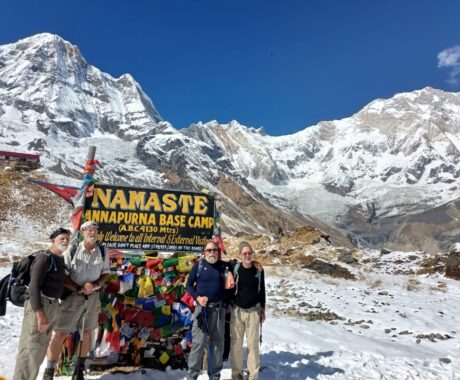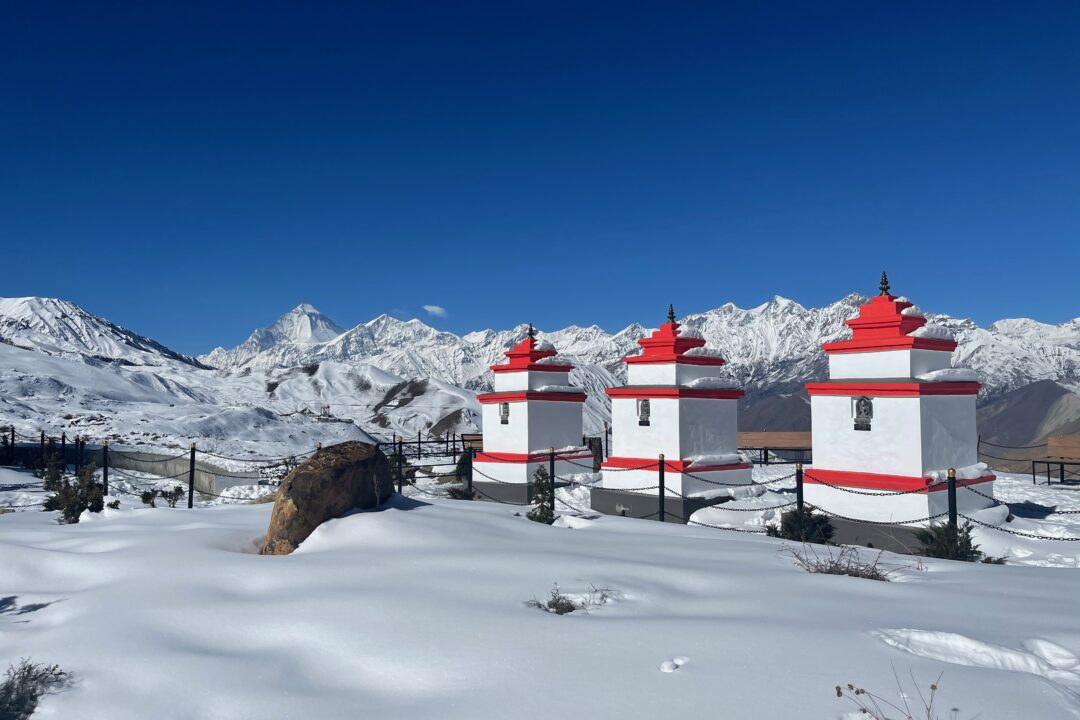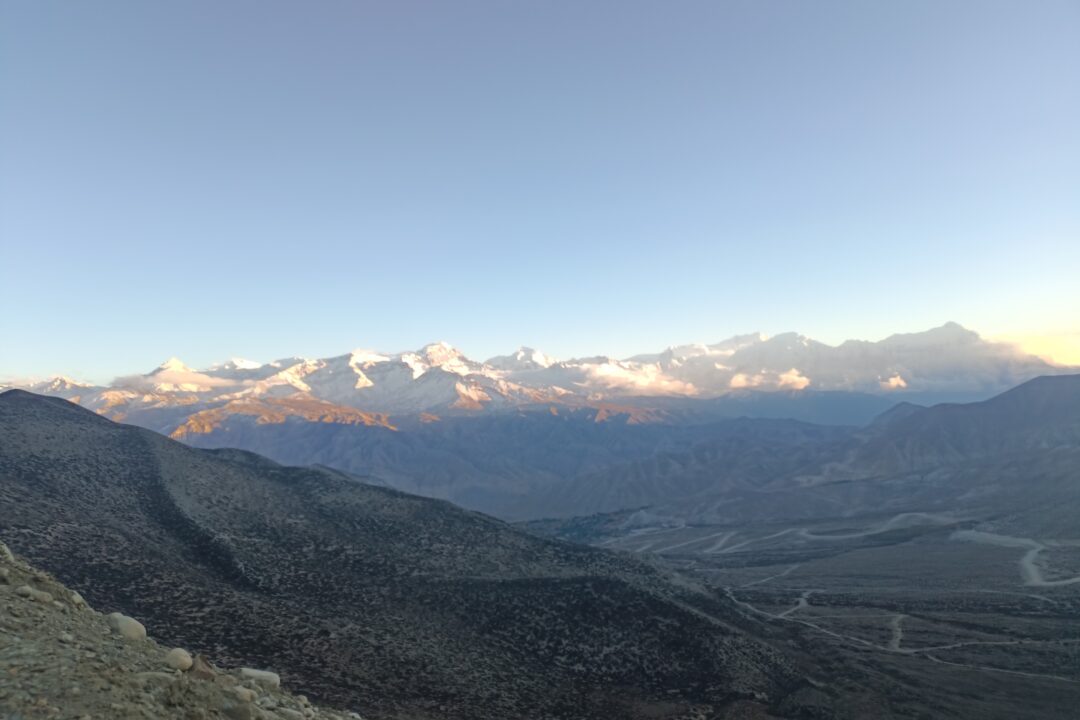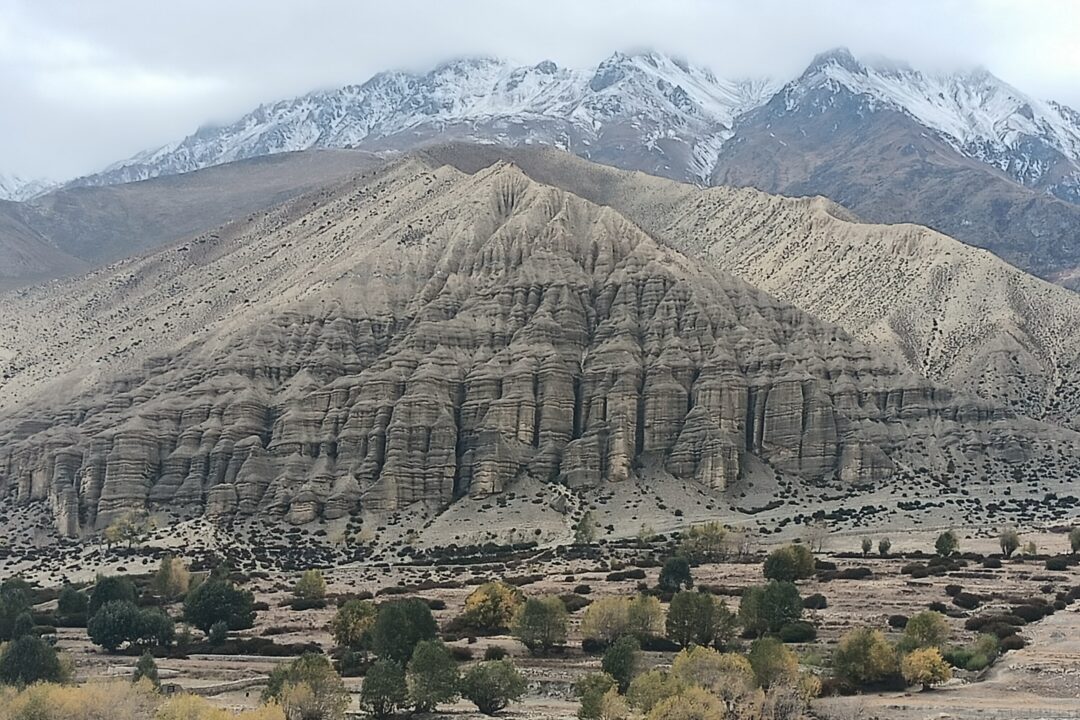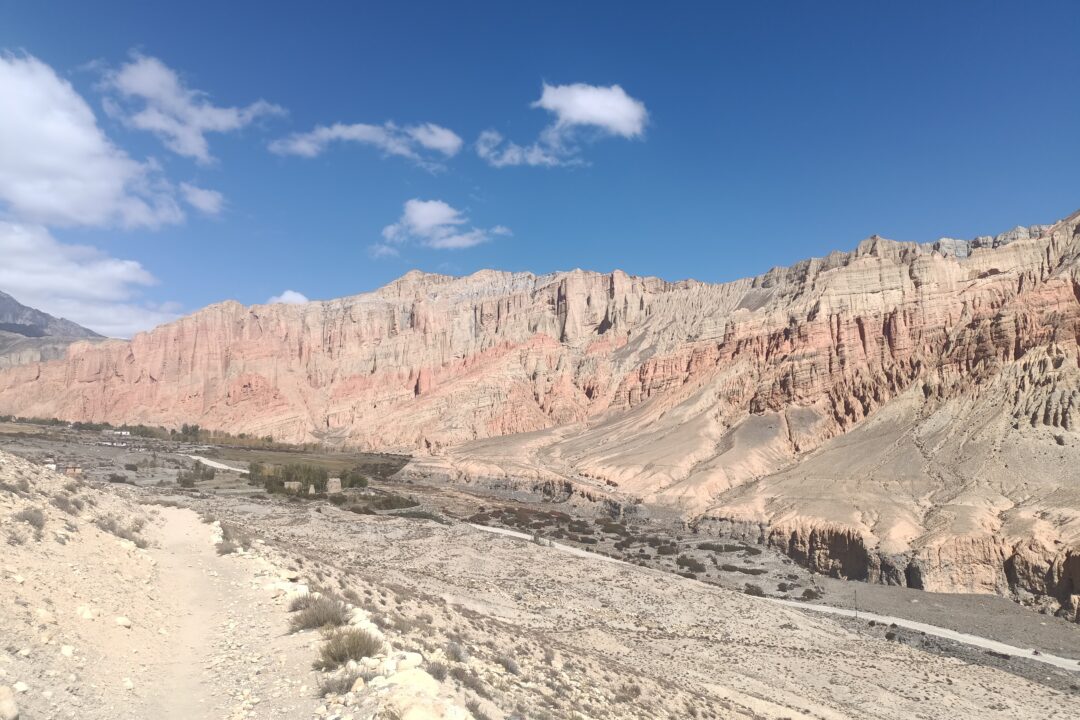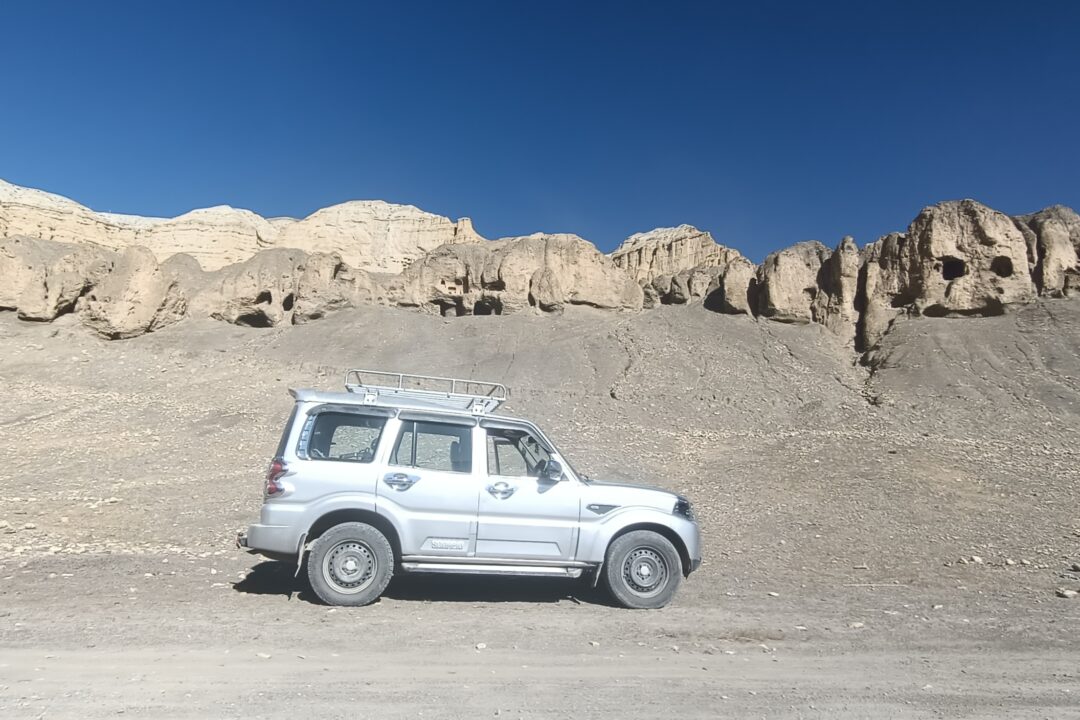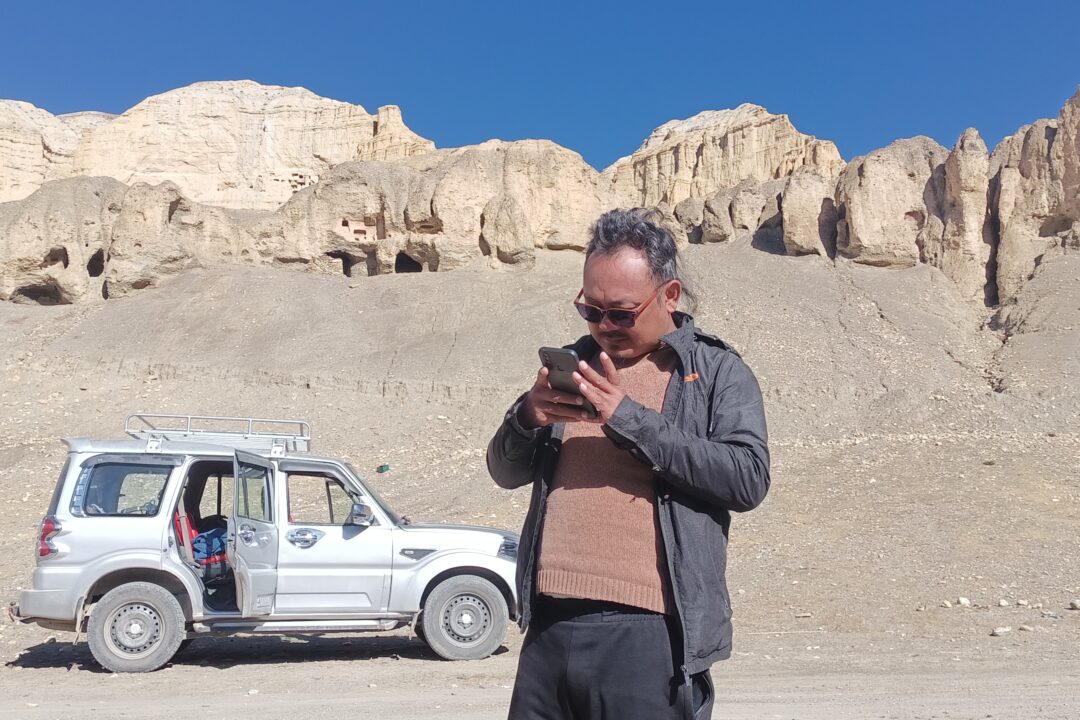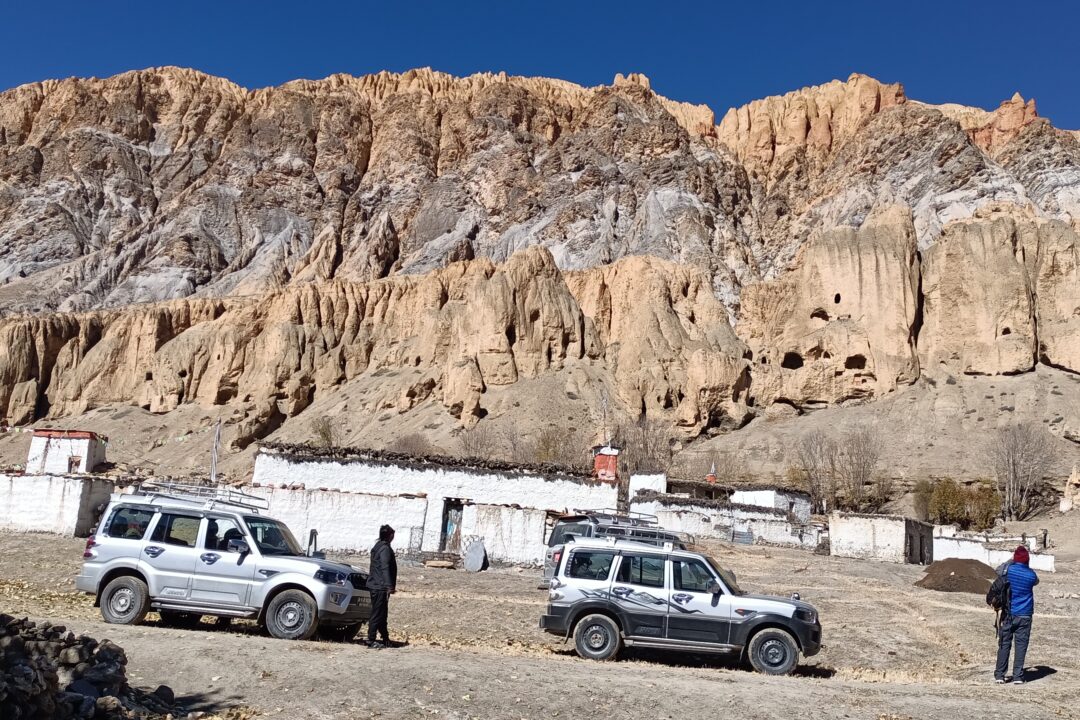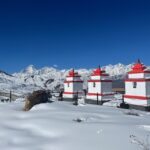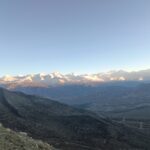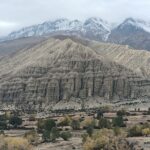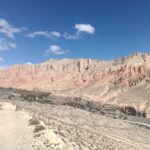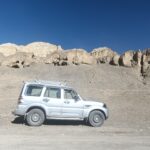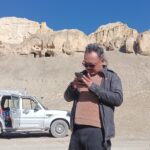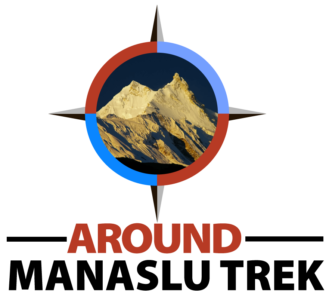Upper Mustang Overland Adventure
Trip Facts
- Destination Nepal
- Activity Tours Trekking
- Duration 13 Days
- Trip Difficulty moderate
- Max. Altitude 4300m
- Best Time Sep to Dec & March to May
- Start and End Kathmandu - Kathmandu
- Meals Breakfast / Lunch / Dinner
- Accommodation 3 star Hotel in Kathmandu and Pokhara & Tea house
- Group Size 2 - 10
- Transportation Private Transport & Kathmandu - Pokhara round flight ticket
Trip Highlights
- Explore the unique country of Mustang an extension of vast Tibetan plateau
- Enjoy the stunning scenery of windswept landscapes with views of snow peaks
- An exciting four-wheel drive through lovely farm villages of Upper Mustang
- Crossing high passes facing grand scenery of dry, arid moonscapes terrains
- Visit the former forbidden ancient walled kingdom of impressive Lo-Manthang
Introduction
Upper Mustang Overland Adventure leads to a magnificent journey on a four-wheel drive around the picturesque country from low, warm areas. Then reaching cooler areas, through the world’s deepest gorge, Kaligandaki River Valley, in between giant Mt. Dhaulagiri (8167 m) and Mt. Annapurna-I.
An exciting ride with dramatic changes in vegetation, climate, and landscapes facing constant views of snow-capped mountains. Upper Mustang Overland Adventure with RP Adventures offers more than one can expect as the drive continues. Reaching the famous apple farmland of the charming villages of Tukuche and Marpha to reach Jomsom.
The headquarters town of the whole Mustang area, from here our true adventure begins. Leaving the Lower Mustang areas and home to the indigenous Thakali people, the tribes of Kaligandaki Valley. The road follows the ancient Trans Himalaya Salt Trade Route of Nepal and Tibet/China.
In the old days’, a caravan of mules and yaks laden with goods passed through this trail to the border of Tibet. Located beyond Upper Mustang towards Karo-La Pass at 4,660 m (15,290 feet), it is the frontier of both countries. It is regarded as the lowest drivable path between the Tibetan Plateau and the southern, lower, warmer subcontinent of Asia.
Enjoy the drive as it enters Upper Mustang, leaving an old, interesting Kagbeni village. The entrance post is where a special permit is required for Upper Mustang, the restricted area in Nepal. The overland journey leads to a wide valley, which is an extension of Tibet’s south-west plateau.
An amazing wild country, as drive heads in between high canyon walls of red earth and high wind-blown cliffs. The drive climbs to cross several scenic passes to enter the traditional and lovely-looking villages of Chusang and Ghami. As the journey approaches, the former walled kingdom of Lo-Manthang, an amazing place, takes you back to the medieval period.
At Lo-Manthang, have time to explore its magnificent monasteries and places of great religious and cultural interest. Along with a sweeping panorama of surrounding windswept moonscapes with arrays of snowy peaks of the Mustang Himal, Enjoying the comfort and warm traditional hospitality of the Lobas, the natives of Upper Mustang.
Return on the same scenic route, but with a difference in the number of overnight stops in beautiful villages. Then slowly, the drive leads back to Kaligandaki River Valley around Lower Mustang, back into tree lines. Then reach the warmer farm country of Mygdi district and take a good road back to scenic Pokhara city. After a marvelous experience on the Upper Mustang Overland Adventure with the grand services of RP Adventures.
Best seasons for Upper Mustang Overland Adventure
- The days are longer with enough sunlight, and the afternoon can get overcast with light snow sometimes. Cold morning and nighttime altitude-wise
- The next right season is autumn/fall (September and October), and most days are fine and crystal clear. For views and pleas
- cold morning and late afternoon until nighttime. We can expect snowfall sometimes, starting in early November, when most lodges will be closed.
- The Upper Mustang villagers migrate to low, warm areas to escape from the cold winter from November to February.
What to Expect on Upper Mustang Overland Adventure?
- An exciting drive from Mygdi warm areas to the cooler hills of Mustang district around Kaligandaki to Upper Mustang
- The drive follows through the world’s deepest gorge, the Kaligandaki River, located between towering Mt. Annapurna and Mt. Dhaulagiri.
- The drive follows through the world’s deepest gorge, the Kaligandaki River, located between towering Mt. Annapurna and Mt. Dhaulagiri.
- The journey leads in between giant, amazing canyons and high, windblown cliffs dotted with small cave holes.
- Exploring lovely villages festooned with an immense culture of Buddhist tradition heritage. Driving in a wide valley on an extension of the Southern Tibetan plateau, facing the outmost scenery of arid landscapes and snow peaks
- Entering the old, former walled kingdom of Lo-Manthang, an ancient city and capital of Mustang. Interact with the warm, friendly Mustang people, similar to Tibetan heritage and cultures.
Outline Itinerary
Day 01: Arrival in Kathmandu and transfer to hotel – 1,300m
Day 02: In Kathmandu with optional sightseeing tour and trek preparations – 1,300m
Day 03: Fly or drive to Pokhara 860m 30 mins by air – 06 hrs on road
Day 04: Drive to Tatopani 1,000m – 05 hrs
Day 05: Drive to Kagbeni 2,830m via Jomsom 2,715m – 06 hrs
Day 06: Drive to Ghami village 3,510m – 05 hrs
Day 07: Drive to Lo-Manthang 3, 840m – 04 hrs
Day 08: At Lo-Manthang free day for acclimatization and exploration 3,840m – Explore the Lomanthang
Day 09: Drive to Chhusang 2,980m – 05 hrs
Day 10: Drive to Kalapani 2,430m via Jomsom – 05 hrs
Day 11: Drive to Pokhara via Kalapani, Tatopani and Beni 1,000m – 06 hrs
Day 12: Drive to Kathmandu 1,300m – 06 hrs
Day 13: International departure for homeward bound – 1,300m
Alternative Treks Around Upper Mustang Overland Adventure
The Upper Mustang Overland Adventure allows you to journey through the mystical landscapes of Mustang without the need for strenuous trekking—perfect for those seeking cultural depth and high-altitude scenery with greater comfort and accessibility. If you’re looking for alternative adventures in similar remote and culturally rich regions, here are some fantastic options:
- Narphu Valley Trek – 14 Days: Explore the hidden valleys of Nar and Phu, tucked behind the Annapurna range, where Tibetan heritage and dramatic terrain create a true wilderness experience.
- Annapurna Circuit Trek – 16 Days: One of Nepal’s most iconic treks, this route combines diverse cultures, dramatic mountain passes, and ever-changing landscapes.
- Upper Dolpo Trek – 28 Days: A remote and rugged journey into one of Nepal’s least explored regions, featuring ancient Bon monasteries, high passes, and stunning trans-Himalayan scenery.
Detailed Itinerary
-
Day 01: Arrival in Kathmandu and transfer to hotel - 1,300m
On arrival at Kathmandu, Nepal International Airport, check the Nepal Standard Time, which is 5 hours and 45 minutes ahead of GMT. Outside the air terminal, our staff from RP Adventures will greet and receive you for a short drive to your hotel. The hotel is located in the hub of Kathmandu; on arrival, check into your lovely rooms. Then meet with other members of the trek for a briefing regarding the Upper Mustang Overland Adventure. After collecting all the useful information and trip details, a group welcome dinner in nice authentic Nepali restaurants was an introduction to Nepali foods and cultures.
Altitude: 1300mMeals: Breakfast / lunch / DinnerAccommodation: 3 Star hotel in Kathmandu -
Day 02: In Kathmandu with optional sightseeing tour and trek preparations - 1,300m
A free day in Kathmandu is preparation for the treks, and you can also enjoy a tour of Kathmandu and Nepal's famous landmarks. Kathmandu Valley and its adjoining cities are steeped with historical monuments listed in World Heritage Sites. Enjoy the tour of Old Durbar Square, the ancient palace and royal courtyard, as well as visiting the oldest Buddhist stupa of Swyambhunath. As well as the famous Hindu temple of Pashupatinath and the large dome stupa of Bouddhanath, and then back to the hotel. After an exciting tour, back to the hotel for the rest of the afternoon preparation for the Upper Mustang Overland Journey.
Altitude: 1300mMeals: Breakfast / lunch / DinnerAccommodation: 3 Star hotel in Kathmandu -
Day 03: Fly or drive to Pokhara 860 m / 30 mins by air - 06 hours on road
Morning as options of flying to Pokhara or taking an exciting overland journey of more than 6 hours. Depending on the road condition of the busiest highway in the country, But it is interesting to observe the in-depth nature of Nepalese rural farm life. The drive takes you through many farm villages and towns before heading west to the beautiful city of Pokhara. Blessed with the natural beauty of lakes, rolling hills, and the peaks of the Annapurna Himalayas. The hotels in Pokhara are situated by the famous and serene Phewa Lake, a great place to explore. (Options by air for a 30-minute panoramic flight to Pokhara from Kathmandu).
Altitude: 850mMeals: Breakfast / lunch / DinnerAccommodation: 3 Star hotel in Pokhara -
Day 04: Drive to Tatopani 1,000m - 05 hrs
After a leisurely breakfast, our overland adventure begins in Pokhara on a four-wheel jeep. The best for the mountainous, rough roads of the Nepal Himalayas and Upper Mustang. The first part of the drive was on a smooth highway to Beni, the headquarters town of Mygdi district in the Dhaulagiri zone. The drive continues on the mud and unpaved road following the Kali Gandaki River to Tatopani for an overnight stop. Check into a lodge and explore the village, which has a natural hot spring as the name of Tatopani.
Altitude: 1000mMeals: Breakfast / lunch / DinnerAccommodation: 3 Star hotel in Tato pani -
Day 05: Drive to Kagbeni 2,830 m via Jomsom 2,715m - 06 hrs
After a refreshing time in Tatopani, the morning starts driving upstream of the Kaligandaki River past farm villages. Then through the world's deepest gorge, Kaligandaki, situated between Mt. Dhaulagiri and Mt. Annapurna-I. From Lete and Kalapani onwards within Mustang District, as the air gets cooler, drive around beautiful woods. Covered in pines and rhododendron trees with views of Annapurna, Dhaulagiri, and Nilgiri’s peaks. As the drive heads past Kalapani, a lovely village, reaching arid and barren country with the lovely villages of Tukuche and Marpha, These areas are famous for apple orchards, then drive leads on gradual winding up to Jomsom. The headquarter town of Mustang district stops at Jomsom for a possible lunch break in a nice restaurant. Afternoon: a short drive around the Kali-Gandaki River windswept valley to reach Kagbeni village for overnight. An interesting old village with strong Tibetan culture, the village is also the entry point for Upper Mustang.
Altitude: 2830mMeals: Breakfast / lunch / DinnerAccommodation: Tea house -
Day 06: Drive to Ghami village 3,510m - 05 hrs
From Kagbeni, after checking with the special permits required to enter Upper Mustang, the journey follows towards a wild barren country. On entering Upper Mustang, the drive leads through great canyon walls and towering windblown hills. Heading towards smaller passes and high ridges of Nyi-La Pass at 3,932 m (12,900 feet). After enjoying panoramic views of the surrounding moonscapes with snow-clad peaks downhill, we went to Ghami village for an overnight in a nice guesthouse. One of the major villages of Upper Mustang has an impressive old Gompa monastery. Ghami village is encircled by a wide field of buckwheat and barley, the only existing high-altitude crops.
Altitude: 3510mMeals: Breakfast / lunch / DinnerAccommodation: Tea house -
Day 07: Drive to Lo-Manthang 3, 840m - 04 hrs
Finally, our adventure heads towards our final and ultimate destination, the forbidden walled kingdom of Lo-Manthang. The morning drive leads around the prayer monument of the Mani walls to Charang, a nice village facing grand scenery of snow peaks. The drive then climbs to a high ridge with views of Lo-Manthang enclosed by high walls. Journey then heads closer to enter the main gate of Lo-Manthang. An amazing old town in a former forbidden kingdom, this place will take you to the medieval period. On reaching the main square of Lo-Manthang, check into a nice lodge or guest house. Houses are built in a traditional Tibetan style. In the afternoon, explore the streets of Lo Manthang, lined with shops and restaurants.
Altitude: 3840mMeals: Breakfast / lunch / DinnerAccommodation: 4 star hotel in Lo-Manthang -
Day 08: At Lo-Manthang free day for acclimatization and exploration - 1,300m
Enjoy a pleasant rest day for a leisure tour around the interesting old city, like the medieval town of Lo Manthang. Visit the Namgyal Gompa, situated on a hilltop, one of the important monasteries in the Mustang area. The tour leads to nearby Tingkhar village, one of the most the most remote and last villages in Lo country. Time permitting, visit the four-story former King Palace-like fort facing grand views of the majestic Mustang Himal range of snow peaks. Lo-Manthang has more than 150 houses with residents for the monks and lama's/head priests. All houses are neatly linked and attached; the fort palace and monasteries are situated at the bottom sections of vertical ‘L'-shaped houses.
The school, health, and police post, including important religious monuments, are located outside the walled kingdom of Lo Manthang, towards the north gate. The tour extends to four great monasteries: Namgyal Gompa, Champa Lhakhang (God House), Red Thubchen Gompa, Chyodi Gompa, and the Great Entrance Hall. A tour of the historical and cultural center is one of the main attractions and highlights of Lo-Manthang.
Altitude: 3840mMeals: Breakfast / lunch / DinnerAccommodation: 4 Star hotel in Lo-Manthang -
Day 09: Drive to Chhusang 2,980m - 05 hrs
After an exciting time at Lo Manthang with a past historical background, I left the former kingdom for a return journey. Heading on the same route through a wide windswept plateau towards the nice village of Chusang.
Enjoy the last overnight stay around Upper Mustang before reaching down to the lower areas of Mustang.Altitude: 2980mMeals: Breakfast / lunch / DinnerAccommodation: Tea house -
Day 10: Drive to Kalapani 2,430m via Jomsom - 05 hrs
Morning, leaving Chusang village to cross high, winding passes and over the streams. The drive follows the Kaligandaki River downstream through arid country landscapes to reach Kagbeni village. The journey continues, following the Kaligandaki River to Jomsom for a lunch break. Afternoon: drive down to Kalapani, a lovely village, for overnight, and back into green hills and lush vegetation. Located beneath Mt. Dhaulagiri and its massif of ice falls and glaciers, with views of Nilgiri’s and Annapurna's Himal ranges.
Altitude: 2430mMeals: Breakfast / lunch / DinnerAccommodation: 3 Star hotel in Kalapani -
Day 11: Drive to Pokhara via Kalapani, Tatopani and Beni 1,000m - 06 hrs
From Kalapani, reach Ghasa, the end of Mustang district, as the drive follows high above the river. The rough road passes through beautiful Rupsi water falls to reach Tatopani village. The ride continues to Baglung or Beni towns, then on the main highway with a pleasant drive downhill to Pokhara. Where our adventurous overland journey to the Upper Mustang concludes before heading back to Kathmandu.
Altitude: 850mMeals: Breakfast / lunch / DinnerAccommodation: 4 Star hotel in Pokhara -
Day 12: Drive to Kathmandu 1,300m - 06 hrs
Morning after early breakfast, an interesting overland journey to Kathmandu.The drive leads on a busy highway, following the Trisuli River for a few hours, and then the drive climbs on a winding road. Then, reaching the Kathmandu valley and back into the city, after an exciting drive, check into your hotels. The rest of the afternoon is at leisure for individual activities. (Options for a scenic short flight of half an hour to Kathmandu from Pokhara).
Altitude: 1300mMeals: Breakfast / lunch / DinnerAccommodation: 3 Star hotel in Kathmandu -
Day 13: International departure for homeward bound - 1,300m
On your final day in Kathmandu and Nepal, it's time for your international flight. Our RP Adventures guides and staff will transfer you to the airport, where you'll bid farewell to the guide and staff. Then, you'll enter the airport terminal for your homeward-bound flight, after a memorable adventure on the Upper Mustang Overland Adventure.
Altitude: 1300mMeals: Breakfast
What's included
- International & Domestics Airport pick up and drop
- 3 star Hotel accommodation in Kathmandu & Pokhara 4 Night (with breakfast included)
- An Experience English speaking guide and porter (1 porter for every 2 trekkers)
- All Meals and Teahouse accommodation during the trek
- Kathmandu Valley Sightseeing with private jeep and tour guide (Local Monuments entrance fee included)
- Kathmandu to Pokhara Flight (Round Trip)
- All required trekking permits (Annapurna Conservation Area Entry Fee and TIMS Card) And Upper mustang special permits
- Guide and porter insurance with food and accommodation
- Basic Medical kits
- Sleeping and duffel bag, down jacket, trekking poles (should be returned after the trek)
- Farewell dinner
- Emergency Helicopter Evacuation Service Arrangement Only (should cover by your travel insurance)
- All required paper works and government taxes
- During the tour Jeep
- RP Adventures T-shirt
What's not included
- International Flight
- Nepal Travel Visa Fee
- Personal Medical and Travel insurance (Should cover helicopter evacuation)
- Guide, Porter and Driver tips
- Personal Gears (equipment)
- Personal bill
- Lunch and Dinner in Kathmandu
- All other personal expense of beverages (hard and soft drinks)
- All other things not mentioned in the inclusion.
Trekking Gears
The Annapurna Region is one of the most popular trekking destinations in Nepal, attracting thousands of trekkers every year. It is renowned for its stunning landscapes, diverse culture, and breathtaking views of the Annapurna mountain range, including Annapurna I, the 10th highest peak in the world.
Trekking in the Annapurna Region offers a variety of routes catering to different preferences and fitness levels. Some of the popular trekking routes in the Annapurna Region include: Annapurna Circuit Trek, Annapurna Base Camp (ABC) Trek, Ghorepani Poon Hill Trek, and Mardi Himal Trek.
To ensure a safe and comfortable trek in the Himalayan region, it is highly recommended to bring the appropriate equipment and gear to cope with the cold temperatures. The following is a list of essential equipment and gear for Upper Mustang Overland Adventure Trek, which can be purchased either in the Thamel market or brought from your home country:
FAQs of Upper Mustang Overland Adventure
-
Why is Upper Mustang a Restricted Area in Nepal for outside visitors?
For many good reasons Upper Mustang district declared as Restricted Areas in Nepal, since it was opened for outside visitors. From 1991 the Upper Mustang flung its door open allowing visitors to explore its beautiful country. As well the rich old cultures of old Buddhism heritage similar to Tibetans just across the border. The main cause is due to its close border between Nepal and Tibet / China, and the other reasons. Is to protect the country pristine environment as it were for hundreds of centuries. Limiting the mass flow of visitors and making Upper Mustang a special and unique place around the Himalayas. -
What types of vehicle do we use on Upper Mustang Overland Adventure?
Depending upon the size of a group and trip cost as per the itinerary, normally taking a drive on jeeps, land cruiser or similar. From Beni and Pokhara onwards the mountain roads are rough on dirt tracks. The best for this types of terrains are a four-wheels drive for comfortable and best ride to enjoy the journey. -
On this trip is there facilities of electricity and internets / WI-FI?
All villages in Mustang have electricity, either powered by hydro or solar energy. Trekkers have facilities to charge their electronic devices and enjoy internet, Wi-Fi, and phone communication. However, in small places like Ghami and Chusang, the internet and Wi-Fi connections are slow and unreliable due to weather conditions and altitude. The landscape, including deep gorges and valleys, also affects connectivity. Travelers may need to wait until they reach areas with better communication, such as Kagbeni, Jomsom, and back in Pokhara. -
How are the lodge accommodation and foods in this trek?
From Kagbeni village onwards, the accommodation meets tourist standards, but most places in Upper Mustang have common baths and toilets due to the harsh and cold climate, especially in the morning, evening, and night. All lodge restaurants offer continental, Chinese, Indian, Nepali, or Tibetan foods served in a nice, warm dining room. -
What documents do we need, and how long does it take to complete this trek?
For this trek, we need your original passport, visa copy, passport-sized photo, guide, guide insurance, and a registered government license holder company. Additionally, special permits and ACAP permits require these documents. -
How much does the trip cost?
The cost will vary depending on your time and budget, ranging from $2000 up to $10,000. -
How much does the permit cost, and how many people are allowed to go in a single group?
The Upper Mustang permit costs $500 for 10 days, plus an additional $30. A group size ranging from 2 to 50 people can travel together, and the permit is issued for only 15 days. There is an additional daily fee of $100 per person. -
Can solo trekkers visit there, and how can they obtain a permit? How much does the permit cost?
Normally, solo trekkers are not allowed to go to Upper Mustang. The process involves a government-licensed trekking guide and agency proposing to the government, taking all the necessary risks. To comply with government regulations, a two-person permit is purchased, which means paying double the permit price. Only then can one visit Mustang. -
What transportation is used to transfer from Kathmandu to Pokhara and Jomsom?
Depending on the budget, we can choose between overland and flight options. In our package, we include air travel from Kathmandu to Pokhara and Jomsom for a roundtrip. we used our luxury jeep during the round trip. -
Which is the best time to go on an Upper Mustang tour and trek?
During the summer in Upper Mustang, the landscape is at its best with vibrant greenery. While other parts of Nepal experience heavy rainfall below 3000m during the summer, Mustang receives less rain due to its mountain desert terrain. -
Why is the Upper Mustang trek permit expensive, and why do we need to go through an agency?
Any restricted area in Nepal, such as Kanchenjunga, Tsum Valley, Manaslu, Nar Phu, Upper Dolpo, and Limi Valley, is designated by the government. These areas are located at the borders of two or three countries, such as India, Tibet, and Nepal. Foreigners were allowed to visit Upper Mustang from 1990 to 2007, and during that time, the permit cost for 10 days was $700, and a government officer needed to accompany the group. However, nowadays, we don't need a government officer; we only need to buy the permit through the agency. The current permit cost is $500 due to the region's designation as a forbidden kingdom and restricted area, making the permit relatively expensive. The strict regulations are in place because of security concerns, leading to the establishment of the region as a restricted area. -
How many kilometers is the distance from Kathmandu to Lo-Manthang to Kathmandu?
The distance from Kathmandu to Lo-Manthang is approximately 350 kilometers. The journey involves a combination of road and trekking routes, taking around 17 hours by road from Kathmandu. -
Where is the location of the Upper Mustang trek?
It is located in the northern part of the Dhaulagiri and Annapurna massif in Mustang, near the Tibetan border. -
How many famous caves and monasteries are there in Upper Mustang?
Some famous caves including Chumshi Cave, Luri Cave, and Choser Cave, and monasteries like Le-Ghar Gompa, Charang Gompa, Ghami Gumba, Giling Gumba, Lo-Manthang Gumba, Choser Gumba, and Lori Gompa are included in this adventure. -
How old are all the caves and monasteries in Upper Mustang?
All the monasteries and caves, such as Choser Cave and Luri Gompa, are 600 years old. -
Why is Lo-Manthang called the old city and Himalayan medical hub center?
The Forbidden Kingdom in Nepal has a capital city in Lo-Manthang, and it is also 600 years old. It serves as a mountain medical hub center, offering access to Ayurvedic and homeopathic treatments. -
How far is it from Lo Manthang to the Koro-La border?
From Lo-Manthang, the capital city of the forbidden kingdom, the Koro-La border is 15 km away. -
How famous is Damodar Kunda and why?
Damodar Kunda is revered in both the Bon religious and Hindu and Buddhist traditions. It holds great significance as the main source of Shaligram (fossil) stones and is considered a sacred lake. -
How high is Damodar Kunda lake, and what is the meaning of Kali Gandaki River?
Damodar Kunda is situated at an elevation of 5400m above sea level. According to Shiva Purana, the Kali Gandaki river is considered the primary source of Damodar Kunda. This river holds immense significance in Hindu religious beliefs, and it is renowned as the sole location in the world where Shaligram (fossil) stones are found. -
Why is Mustang called the forbidden kingdom, and why is the king still important there?
Mustang is a less explored Himalayan region, thus earning its title as a forbidden kingdom. According to Buddhist culture and local traditions, people hold great respect for the king, who actively engages and collaborates with the community to address and solve various issues. -
What is the meaning of Zong (wall of mud and stone), and how important and how old is it?
It is a historical aspect of the forbidden kingdom where everywhere we can see walls of houses that depend on the King's old Palace, dating back around 400 to 500 years. It is crucial for research, providing insights into how people lived long ago, serving as a valuable research tool. -
What is the meaning of Lo-Manthang, and how big is it?
The words "Min" and "Thang" combine to form "Lo-Manthang," and according to local people, it means an Ayurvedic hub. It is neither too big nor too small, comprising around 200 houses in this village. -
Is this a famous tour and trekking route in Nepal?
Yes, it is very famous for the tour and trekking, attracting different people to experience various landscapes, mountains, high mountain valleys, and typical mud house villages. -
Do you still have an active king there, and do you know the name of the last king of Mustang?
No, there is no longer an active king in Mustang. The last king of Mustang was Jigme Dorje Palbar Bista. The monarchy in Mustang officially ended in 2008 when Nepal became a federal democratic republic. -
What types of culture do the Mustang people follow?
Mustang people are typical Thakali and Gurung individuals who follow Tibetan Buddhism and culture. -
Is it possible to reach every village by driving transportation?
In Upper Mustang, during the winter and spring when the weather is fine, we can visit all those areas. -
How famous is the Tiji festival in Upper Mustang, and during which time do people celebrate it?
Tiji is one of the important festivals in Upper Mustang, celebrated on May 5, 6, and 7 in 2024. -
What is the lifestyle of the people in Upper Mustang?
The lifestyle in Upper Mustang is characterized by engaging in agriculture and animal husbandry for sustenance. Thirty years ago, the marriage system involved multiple brothers sharing one wife within a family. However, this particular marriage system is no longer prevalent in the present day. -
How long has it been remote area, and how much has it changed in the last 40 years?
For forty years, Upper Mustang was an extremely remote area, earning it the designation of a forbidden kingdom. Travelers seeking to reach Pokhara and Kathmandu had to embark on a month-long roundtrip journey. In the present day, accessibility to Mustang has significantly improved. A helicopter ride takes approximately one and a half hours, while a bus journey from Kathmandu to Mustang lasts around seventeen hours. The ease of reaching Mustang now depends on individuals' time constraints, budget considerations, and personal interests. -
What views can we see during the tour and trek from Kathmandu to Kathmandu?
When we embark on the trip from Kathmandu, whether by land or by flight, the journey offers stunning views. The panoramic sights include the cityscape of Kathmandu, prominent Himalayan peaks such as Ganesh Himal, Manaslu, the entire Annapurna range, Dhaulagiri, Machhapuchre, Nilgiri, Tilicho Peak, Thorang Peak, Damodar Peak, Saribung Peak, Bhrikuti Peak, Dhampus Peak, Tukuche Peak, Yakungkhang Range, the Kaligandaki Valley, and the picturesque landscape of Pokhara. The route also takes us through mountainous desert landscapes, creating a captivating visual experience. -
Why is Upper Mustang called a mountain desert place, and why do people refer to it as mini Tibet?
In Upper Mustang, we refer to it in Nepali as a mountain district characterized by the absence of a tree line and the presence of only bushy trees. The region resembles a desert due to the lack of irrigation and minimal rainfall. The culture, language, landscape, and proximity to the Tibetan border are reminiscent of Tibetan characteristics. Around 700 years ago, Guru Padmasambhava meditated in this region. During his time, people inhabited caves, and when Padmasambhava arrived, he vanquished demons through Tantric Buddhism. Following this, people started living outside the caves and established a city. This historical background, combined with its geographical and cultural similarities to Tibet, earned Upper Mustang the nickname "mini Tibet." -
Is horse riding tour famous in Mustang, and what is the best time to do it?
In Mustang, ten years ago, horse riding tours were very popular. Nowadays, with the availability and affordability of jeeps, horse riding tours are not as popular. However, if people still wish to experience horse riding, they can do so in the areas around Lo-Manthang, Charang, and Ghar Gompa. This has become a local transport option in the last ten years. For horse riding tours in Mustang, it is recommended to do them in April during spring or in September and October during autumn. -
Why are "chhorten and stupa" so different in Upper Mustang and Upper Dolpo?
This is a traditional and typical chorten in Nepal. In modern regions of Nepal, chortens are modified using different materials and colors. However, the old chortens in Mustang and Upper Dolpo still adhere to the traditional style and are not allowed to be modernized due to their location in restricted areas and their status as symbols of the forbidden kingdom. -
What is the meaning of Luri cave and Luri gompa, and Li-Ghar gompa?
**Luri Cave and Luri Gompa:** Luri Cave, an ancient cave complex in Upper Mustang, exhibits exquisite Tibetan Buddhist murals dating back to the 15th century. Luri Gompa, an adjacent monastery, complements the cave's spiritual significance. **Li-Ghar Gompa:** Li-Ghar Gompa, nestled in Mustang, serves as a Buddhist monastery with traditional Tibetan architecture. Beyond religious functions, it fosters community gatherings, cultural events, and plays a crucial role in preserving Mustang's unique heritage. -
Is it possible to do a helicopter tour in Lo-Manthang and Damodar Kunda?
Yes, it is possible. If we want to visit those places, we have to follow the government rules and buy a 10-day permit for a one-hour visit. If yes, you can do it. -
What types of birds and animals can we see during the tour and trek, and why are animals small in size?
During the Upper Mustang tour and trek, you may encounter various birds like Tibetan Snowcock and animals such as wild yaks, donkeys, and domestic livestock. The harsh Himalayan environment influences animals to adapt with smaller body sizes, conserving energy and enhancing survival in the challenging terrain. These adaptations facilitate their efficient navigation through the rugged landscapes of Mustang. -
What is the tipping rule for the driver, porter, and guide?
From your full package, ten percent is deducted to tip the trekking members. -
Can we have a historical guide in Lo-Manthang?
Yes, normally we hire a tour guide for Lo-Manthang. Lo-Manthang does not have many tour guides; only one or two guides are available. If we don't get a guide, we have to follow the monk. -
How many world heritage sites are there in Kathmandu?
There are seven UNESCO World Heritage Sites in Kathmandu, Nepal: -
What are the possibilities in emergency cases?
In case of emergency, you will receive a helicopter rescue, or you will be transported to a major city by land ambulance for your recovery. -
Why or How RP Adventures is different than others?
RP Adventures offers an exclusive and high-end trekking experience with its expensive packages. The allure lies in the luxurious accommodations, highly qualified and experienced guides with excellent educational and medical training, ensuring a safe and enriching journey. Private ground transportation adds to the comfort, while the option of helicopter sharing for aerial transport, especially in remote areas, enhances the adventure. The commitment to quality services and safety justifies the elevated cost, providing clients with a truly premium and unforgettable trekking and tour experience. -
Do you have an another package (budget) as well?
Yes, we offer budget packages for trekking that allow you to choose your own meals. While the trekking routes and permits remain the same, the level of service, including accommodations, food, and guide/porters, varies based on your budget. You can opt for accommodation ranging from 2-star to 5-star hotels, providing flexibility and affordability for your trekking adventure.
Trip You May Like
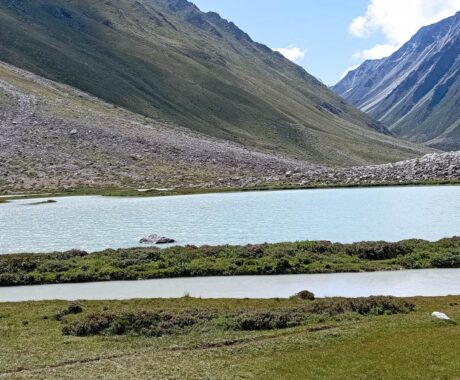
Limi Valley Trek
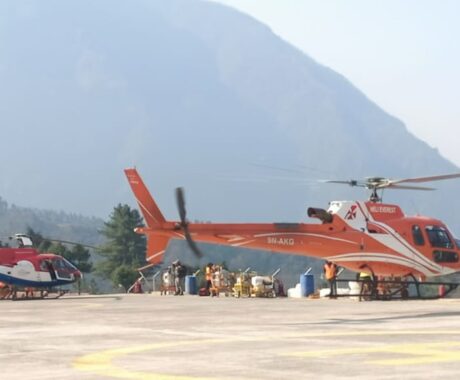
Kathmandu & Everest Base Camp Helicopter Tour
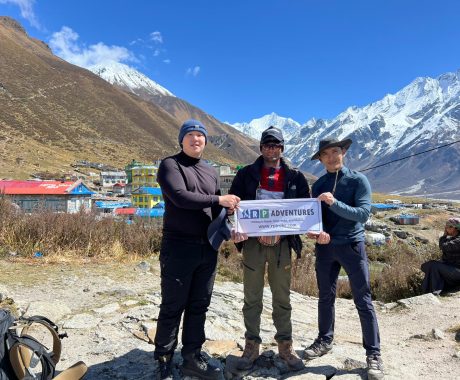
Langtang Valley Trek
